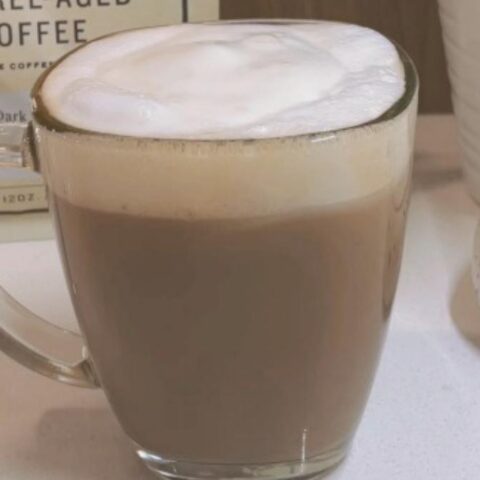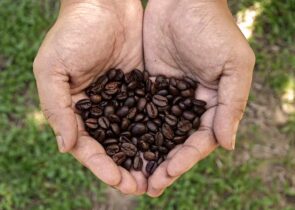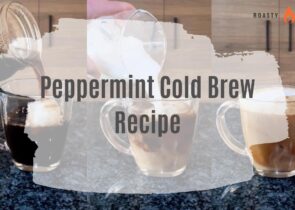No matter how much you love your morning coffee, you’ll probably want to switch things up sometimes.
That’s where the bourbon barrel-aged latte comes in. This drink is perfect for anyone who wants to upgrade the contents of their coffee bar without getting too crazy. We’ve got all the instructions to make it — plus more information about this coffee trend — below.

What Is Barrel-Aged Coffee?
The aging of coffee beans in alcohol barrels involves leaving the joe in retired liquor barrels for at least two weeks. During this time, the green coffee beans absorb all the flavors and aromas left behind by the alcohol that once inhabited the vessel.
Then, the beans make their way to the roaster and, eventually, your house, ready to be used with your favorite method for brewing coffee.
Check out our detailed guide to find out what barrel-aged coffee is.
Why Try a Latte Made With Barrel-Aged Coffee?
Choosing beans that underwent the barrel-aging process over regular coffee beans lets you do the following:
Keep up with coffee trends
Whether you pride yourself on staying up to date with current coffee drink trends or are still recovering from the embarrassment of being the last one in your friend group to find out about Dalgona coffee in 2020, you’ll want to get in on this joe.
The barrel-aging process has been around for a few years, and plenty of companies — even large ones like Starbucks — have hopped on the bandwagon. You can read about how these products compare to regular coffee beans, but the best way to see if it lives up to the hype is to try one of them yourself.
Experience a unique flavor profile
Barrel-aging coffee allows a batch of beans to take on the characteristics of the liquid that occupied the space prior, so they take on tasting notes plus a distinct woodiness non-aged coffee beans do not.
Bags of barrel-aged coffee rarely tastes the same, even if they spent time in the same container. This is because the beans absorb a little more of the alcohol’s aroma and taste characteristics each time coffee producers use the barrel.
Spice up your coffee routine
Maybe you brew your drinks yourself, or perhaps you let the barista at one of your local coffee shops whip them up. Regardless of who made it and where it came from, making the same choice in coffee drinks every day can get old quickly.
That’s one reason trying barrel-aged coffee is a good idea; it lets you experience new yet enjoyable flavors without having to use add-ins or splurge on expensive new gadgets. You might be surprised how much an act as small as switching beans can impact your routine.
How to Make a Bourbon Barrel-Aged Latte

@roastycoffee #coffeetok #lattetok #specialtycoffee ♬ Glimpse of Us – Joji
View our Google web story here.
You’ll Need:
- Bourbon barrel-aged coffee beans
- The coffee maker of your choice
- Milk of choice
- Milk steamer
- A glass
- A mug
- Burr coffee grinder
The Process:
Step 1:

Begin by pulling out your bag of delicious barrel-aged coffee beans and use a coffee grinder to break them into appropriately sized* pieces for your preferred brewing method.
We used Pappy & Company’s bourbon whiskey barrel-aged beans, as we’re big fans of the joe’s mellow flavor. However, several companies sell barrel-aged coffee, so you shouldn’t have trouble finding something good to brew.
Step 2:

After grinding your joe, it’s time to brew it! We’ve used an AeroPress and an espresso machine to make our bourbon barrel-aged coffee and can confirm both produce satisfying results. But, of course, you can use whatever brewing device you have.
Pour the freshly brewed coffee into a mug.
Step 3:

Add milk to a glass and use a frother to create a layer of bubbly milk foam. We used almond milk, but feel free to use whatever milk or milk alternative you like best.
Step 4:

Pour the frothy foam atop your cup of coffee, and ta-da! You’ve got a simple, bourbon flavor-infused spin on the classic latte.
*Each brewing device requires different-sized coffee grounds. Consult our coffee grind size chart if you’re unsure what grinder setting to use.
About the Coffee Beans
As long as they aged in a bourbon barrel, any coffee beans will work for this recipe. However, we used Pappy & Company’s bourbon barrel-aged beans.
Before this Guatemalan java made its way to Pappy & Company’s coffee production partner, Good Folks Coffee, to roast to medium-dark excellence, small batches of it aged in Pappy Van Winkle bourbon barrels.
The result is a batch of beautiful coffee beans that smells and tastes lovely enough to please even the most adamant bourbon hater.
Try them brewed hot in this latte recipe one day, then pull out your trusty cold brew coffee maker and enjoy the joe over ice the next. It’s good stuff, no matter how you make it!
FAQs: A Barrel-Aged Bean Breakdown
Is there alcohol in barrel-aged coffee?
Sorry to disappoint our Roasty readers who were hoping for a buzz; barrel-aged coffee beans don’t have any alcohol — at least, not enough to affect you, as the heat from the roasting process burns it out.
Trace amounts of the substance may remain after the green coffee beans roast, but in those cases, there’s so little of it that you won’t even know it’s there.
You don’t need a batch of barrel-aged beans if sipping something boozy is your goal; break out the coffee cocktail recipes instead.
What does barrel-aged coffee taste like?
How barrel-aged joe tastes depends on the type of alcohol barrel used. For example, taking a sip of coffee made from whiskey-aged beans leaves nuttier flavors dancing on your taste buds, while bourbon barrel-aged coffee has a sweeter taste and hints of vanilla.
On the other hand, rum barrel-aged coffee has a distinct sweetness reminiscent of caramel, and beans aged in wine barrels have an earthier flavor profile.
Who invented barrel-aged coffee?
While the exact identity of the person who first tried barrel-aging unroasted coffee beans isn’t known, Annapolis-based coffee roaster Ceremony Coffee usually receives the credit for pioneering this trend.
Think Outside the Box with Barrel-Aged Beans
Adding barrel-aged brew to your classic latte may be just what you need to add a little pizzazz to your everyday coffee routine. But don’t take our word for it; buy a batch of these barrel-aged beans and see why specialty coffee lovers are crazy about this joe.
Happy Caffeinating!

Bourbon Barrel-Aged Latte Recipe
Bourbon Barrel-Aged Latte is a coffee drink that contains an incredible aroma absorbed from the alcohol left in the liquor barrels.
Ingredients
- Bourbon barrel-aged coffee beans
- The coffee maker of your choice
- Milk of choice
- Milk steamer
- A glass
- A mug
- Burr coffee grinder
Instructions
- Pull out your bag of delicious barrel-aged coffee beans and use a coffee grinder to break them into appropriately sized* pieces for your preferred brewing method.
- Brew your bourbon barrel-aged coffee using AeroPress or an espresso machine.
- Add milk to a glass and use a frother to create a layer of bubbly milk foam.
- Pour the frothy foam atop your cup of coffee, and enjoy!







